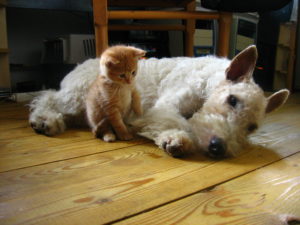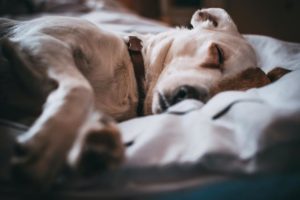Last Updated on September 20, 2023
YES!
Dogs can be carriers of lice. However, lice in dogs are different from that of human lice. Can the lice of my dog be passed on to me or my child? Thankfully no. Lice are species-specific parasites. Dog lice need dog blood to survive and human head lice need human blood to survive. This goes the same for cat lice as well. If by any chance head lice fall on your dog’s coat, the lice won’t be able to survive.
Contrary to popular belief, a lice infestation is uncommon in pets. Lice infestation is most frequently found in homeless dogs or dogs living in unsanitary environments. As a matter of fact, lice are rare in the United States. They are more common in tropical areas. However, a recent study showed that climate change is starting to change this behavior of parasites. A hotter and wetter climate allows disease-carrying parasites to adapt to drier, cooler environments. In retrospect, climates they wouldn’t have survived years ago.
Nonetheless, if you suspect your dog has lice, there is no need to fret. Lice are treatable and can be prevented. Keep on reading to learn where your dog might get them, possible treatments, and prevention.
What are lice?
Dog lice are small, flightless, six-legged insects that live in the hair of dogs. Their six legs have claws on each end allowing them to cling on to the hair shaft. Their claws are what make them species-specific. Dog lice have specifically made claws for a dog’s hair shaft. In the same way that claws of cat lice have special claws made for a cat’s hair shaft as well. These strong claws allow them to hang on tightly to the hair shaft that even vigorous scratching cannot dislodge them. Imagine how frustrating this must be for our pets!
Basically, there are two types of lice: biting lice and blood-sucking lice. Biting lice or chewing lice feed on skin debris and sebaceous secretion. They infest in both birds and mammals. Blood-sucking lice, on the other hand, need blood to survive. They have a sharp mouthpiece and are found to infest in mammals only. Both of these types are dangerous for dogs as they can carry certain types of diseases like tapeworms.
3 species of lice that can be found in dogs:
- Linognathus setosus (a bloodsucking louse)
- Trichodectes canis (a biting louse)
- Heterodoxus spiniger (a biting louse that feeds on blood)
There are three stages in a louse life cycle. Adult female lice lay their eggs, called nits, in the hair close to the dog’s skin. The nits cannot be removed by ordinary shampooing and combing alone. They are translucent, pale, almost oval in shape, and are dandruff looking. When the nits hatch, an immature louse is released and an empty shell is left on the hair shaft. Nymphs, as what they are called in this stage, look like an adult louse but smaller in comparison. In a span of a week, they molt several times until they become adults and start the cycle once again. The Merck Veterinary Manual says that the entire cycle from eggs to adults takes about 3-4 weeks.
What causes them?
Lice can be easily transmitted through close contact. If your dog frequents to pet stores, pet daycares, pet shows, pet adoption centers, group walks, and dog parks, its where he most likely got the lice. Dog lice will take advantage of any situation where dogs usually gather. In the same way, grooming salons are also a probable place. Improper sanitation of grooming tools can transfer lice from dog to dog. I recommend asking grooming salons how often they clean their grooming tools and the places where they keep their pets. Grooming salons can not only transfer lice but kennel cough, fleas, rabies, and fungal infections as well.
How do I know if my dog has lice?
The first sign of a lice infestation is extreme itching. Lice love to linger around the ears, neck, shoulders, groin, and rectal regions. Itching, scratching, and biting in these areas are worth checking out for lice infestation. In extreme cases, hair loss and matting are found in the same areas. In some cases, small wounds may also be present if your dog is infested with the biting kinds of lice. In young pups, anemia is a common occurrence.
But how do I know for sure that it is lice that are causing his restlessness? To do this, a close inspection of your dog’s coat is needed. A diagnosis is made by seeing lice, nymphs, or nits in your pet. Parting the hair using a fine-toothed comb and a magnifying glass to look for empty, dandruff-looking lice eggs can help. If you notice one or two, try ruffling the coat. If it falls, it’s just dandruff and debris. If it doesn’t dislodge, it is most probably empty nits. You can also check for nymphs and adult lice on your dog’s coat this way. You can differentiate fleas from lice by their color and speed. Fleas are darker in color and are faster to move compared to lice.
So what’s the solution?
Lice are best treated with a veterinarian. Lice infestations are rare in pets. You mustn’t self-diagnose your pet because fleas and lice are commonly mistaken for each other. Flea treatment is different from lice treatment.
With that said, your veterinarian can recommend a lice control treatment appropriate for his age, breed, and health. If your dog has wounds from lice, your veterinarian may also give you a topical antibiotic or other medications. Bathing your dog with a flea shampoo can help remove adult lice and nymphs but not remove nits. The lice eggs can still hatch and a new batch of lice can remain. This is where the follow-up lice treatments become crucial and where vet guidance is needed. If you have two or more house pets, keeping your infected pet isolated from others can prevent spreading. But even with or without symptoms, get them checked by the vet to avoid lice from recurring.
At home, you’ll need to wash and sanitize your dog’s personal items. Dog beds, dog leashes, coats, and collars need to be washed by hot water with flea shampoo to prevent reinfestation. Appropriate sprays can also be used to clean the places where your dog mostly stays.
How can I prevent lice infestation in the future?
With proper management, lice infestations can become a thing of the past. Ask your vet for a year-round flea and tick prevention to help control lice infestations in the future. Flea collars are also highly effective and are widely available in the market. Regular cleaning of dog beds and bathing them often can help. Avoiding direct contact with dogs that scratch is recommended.
Conclusion
Lice infestation can cause extreme distress in our pets. However, it is good to know that lice cannot be passed on from family pets to humans and vice versa. One of the early signs you should look for in your pets is severe itchiness and matting of the fur. In some cases, small wounds are present specifically in the neck, ears, and groin where lice are commonly hidden. Seek the professional opinion of vets for proper treatment. Flea shampoos and annual flea and tick prevention control can help prevent lice infestations in the future. Regular visits to the vet and keeping a clean environment for our pets can also go along way.
Related: Can Dogs Be Allergic to Other Dogs?











